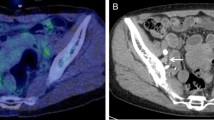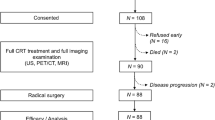Abstract
Purpose
The diagnostic and prognostic value of 18F-FDG PET in cervical adenocarcinoma/adenosquamous carcinoma (AC/ASC) is unclear. The aim of this study was to assess the value of PET in the management of cervical AC/ASC.
Methods
Patients with resectable FIGO stage IB/IIB cervical AC/ASC receiving a preoperative MRI scan and a PET or PET/CT scan before radical surgery were eligible. Diagnostic efficacy was compared by receiver operating characteristic (ROC) analysis. Correlations between clinicopathological parameters and outcome and maximum standardized uptake values (SUVmax) of FDG uptake were evaluated.
Results
The study group comprised 83 patients (mean age 48.3±9.7 years) Five-year overall survival was 85.5%, with a median follow-up time of 38.6 months (range 2.8–87.2 months). Pelvic lymph node (PLN) and paraaortic lymph node (PALN) metastases were seen in 32.5% and 8.4% of patients, respectively. The difference in diagnostic efficacy in identifying metastatic PALN between PET and MRI was significant (PET versus MRI, area under the curve 0.832 versus 0.607, p=0.039). SUVmax in primary tumour was correlated with LN metastasis and deep stromal invasion. Overall survival was significantly related to FIGO stage, PLN metastasis, deep cervical stromal invasion, tumour size measured by MRI, and SUVmax of the primary cervical tumour.
Conclusion
PET provided significantly better diagnostic efficacy than MRI in detecting PALN metastasis. Poor prognostic factors in cervical AC/ASC were SUVmax of the primary cervical tumour >5.3, stage IIB, deep cervical stromal invasion, tumour size measured by MRI ≥40 mm, and PLN metastasis.



Similar content being viewed by others
References
Parkin DM, Bray F, Ferlay J, Pisani P. Global cancer statistics, 2002. CA Cancer J Clin 2005;55:74–108.
Wang SS, Sherman ME, Hildesheim A, Lacey JV Jr, Devesa S. Cervical adenocarcinoma and squamous cell carcinoma incidence trends among white women and black women in the United States for 1976–2000. Cancer 2004;100:1035–44.
Chen YY, You SL, Chen CA, et al. Effectiveness of national cervical cancer screening programme in Taiwan: 12-year experiences. Br J Cancer 2009;101:174–7.
Bray F, Carstensen B, Moller H, et al. Incidence trends of adenocarcinoma of the cervix in 13 European countries. Cancer Epidemiol Biomark Prev 2005;14:2191–9.
Landoni F, Maneo A, Colombo A, et al. Randomised study of radical surgery versus radiotherapy for stage Ib-IIa cervical cancer. Lancet 1997;350:535–40.
Lai CH, Hsueh S, Chang TC, et al. Prognostic factors in patients with bulky stage IB or IIA cervical carcinoma undergoing neoadjuvant chemotherapy and radical hysterectomy. Gynecol Oncol 1997;64:456–62.
Eifel PJ, Burke TW, Morris M, Smith TL. Adenocarcinoma as an independent risk factor for disease recurrence in patients with stage IB cervical carcinoma. Gynecol Oncol 1995;59:38–44.
Lai CH, Hsueh S, Hong JH, et al. Are adenocarcinomas and adenosquamous carcinomas different from squamous carcinomas in stage IB and II cervical cancer patients undergoing primary radical surgery? Int J Gynecol Cancer 1999;9:28–36.
Mitchell DG, Snyder B, Coakley F, et al. Early invasive cervical cancer: tumour delineation by magnetic resonance imaging, computed tomography, and clinical examination, verified by pathologic results, in the ACRIN 6651/GOG 183 Intergroup Study. J Clin Oncol 2006;24:5687–94.
Rose PG, Adler LP, Rodriguez M, Faulhaber PF, Abdul-Karim FW, Miraldi F. Positron emission tomography for evaluating para-aortic nodal metastasis in locally advanced cervical cancer before surgical staging: a surgicopathologic study. J Clin Oncol 1999;17:41–5.
Grigsby PW, Siegel BA, Dehdashti F. Lymph node staging by positron emission tomography in patients with carcinoma of the cervix. J Clin Oncol 2001;19:3745–9.
Yen TC, Ng KK, Ma SY, et al. Value of dual-phase 2-fluoro-2-deoxy-d-glucose positron emission tomography in cervical cancer. J Clin Oncol 2003;21:3651–8.
Chang TC, Law KS, Hong JH, et al. Positron emission tomography for unexplained elevation of serum squamous cell carcinoma antigen levels during follow-up for patients with cervical malignancies: a phase II study. Cancer 2004;101:164–71.
Xue F, Lin LL, Dehdashti F, Miller TR, Siegel BA, Grigsby PW. F-18 fluorodeoxyglucose uptake in primary cervical cancer as an indicator of prognosis after radiation therapy. Gynecol Oncol 2006;101:147–51.
Lai CH, Yen TC, Chang TC. Positron emission tomography imaging for gynecologic malignancy. Curr Opin Obstet Gynecol 2007;19:37–41.
Chou HH, Chang TC, Yen TC, et al. Low value of [18F]-fluoro-2-deoxy-D-glucose positron emission tomography in primary staging of early-stage cervical cancer before radical hysterectomy. J Clin Oncol 2006;24:123–8.
Choi HJ, Roh JW, Seo SS, et al. Comparison of the accuracy of magnetic resonance imaging and positron emission tomography/computed tomography in the presurgical detection of lymph node metastases in patients with uterine cervical carcinoma: a prospective study. Cancer 2006;106:914–22.
Roh JW, Seo SS, Lee S, et al. Role of positron emission tomography in pretreatment lymph node staging of uterine cervical cancer: a prospective surgicopathologic correlation study. Eur J Cancer 2005;41:2086–92.
Wright JD, Dehdashti F, Herzog TJ, et al. Preoperative lymph node staging of early-stage cervical carcinoma by [18F]-fluoro-2-deoxy-D-glucose-positron emission tomography. Cancer 2005;104:2484–91.
Sironi S, Buda A, Picchio M, et al. Lymph node metastasis in patients with clinical early-stage cervical cancer: detection with integrated FDG PET/CT. Radiology 2006;238:272–9.
Hong JH, Tsai CS, Wang CC, et al. Comparison of clinical behaviors and responses to radiation between squamous cell carcinomas and adenocarcinomas/adenosquamous carcinomas of the cervix. Chang Gung Med J 2000;23:396–404.
Moberg PJ, Einhorn N, Silfversward C, Soderberg G. Adenocarcinoma of the uterine cervix. Cancer 1986;57:407–10.
Irie T, Kigawa J, Minagawa Y, et al. Prognosis and clinicopathological characteristics of Ib-IIb adenocarcinoma of the uterine cervix in patients who have had radical hysterectomy. Eur J Surg Oncol 2000;26:464–7.
Cohn DE, Peters WA 3rd, Muntz HG, et al. Adenocarcinoma of the uterine cervix metastatic to lymph nodes. Am J Obstet Gynecol 1998;178:1131–7.
Baalbergen A, Ewing-Graham PC, Hop WC, Struijk P, Helmerhorst TJ. Prognostic factors in adenocarcinoma of the uterine cervix. Gynecol Oncol 2004;92:262–7.
Lai CH, Chang CJ, Huang HJ, et al. Role of human papillomavirus genotype in prognosis of early-stage cervical cancer undergoing primary surgery. J Clin Oncol 2007;25:3628–34.
Kasamatsu T, Onda T, Sawada M, et al. Radical hysterectomy for FIGO stage I-IIB adenocarcinoma of the uterine cervix. Br J Cancer 2009;100:1400–5.
Acknowledgment
This study was supported by grants CMRPG-340011-12, CMRPG32022, and CMRPG-340052 from the Chang Gung Memorial Hospital at Linko.
Conflicts of interest
None.
Author information
Authors and Affiliations
Corresponding author
Additional information
Hung-Hsueh Chou and Hsiu-Ping Chang contributed equally to this work.
Rights and permissions
About this article
Cite this article
Chou, HH., Chang, HP., Lai, CH. et al. 18F-FDG PET in stage IB/IIB cervical adenocarcinoma/adenosquamous carcinoma. Eur J Nucl Med Mol Imaging 37, 728–735 (2010). https://doi.org/10.1007/s00259-009-1336-1
Received:
Accepted:
Published:
Issue Date:
DOI: https://doi.org/10.1007/s00259-009-1336-1




